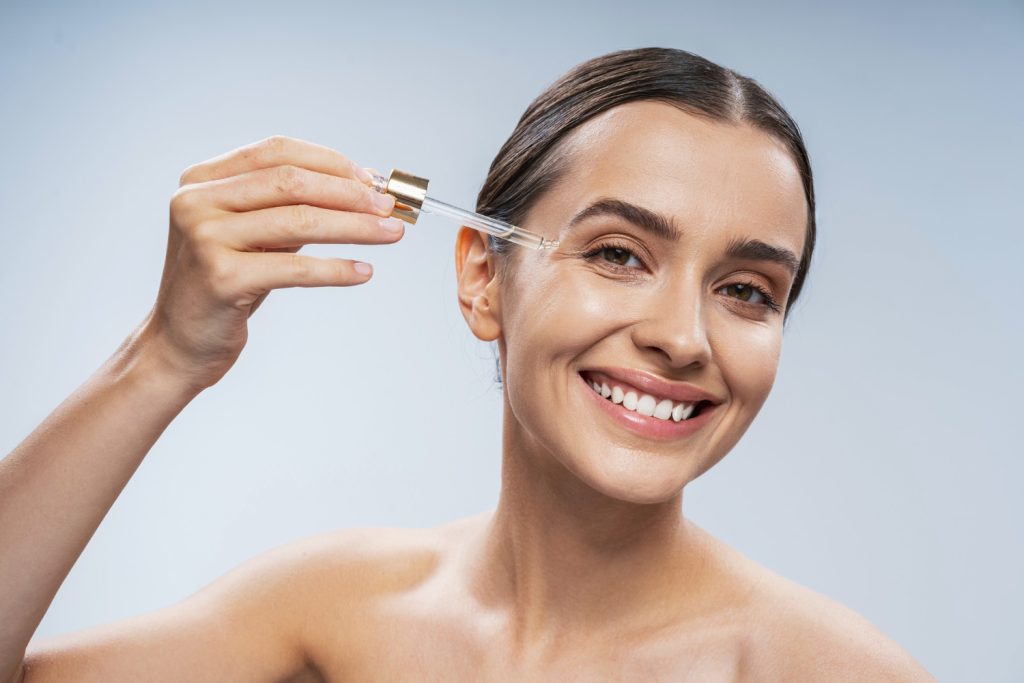Glycolic Acid vs Salicylic Acid: How To Choose What Is Best For You?

- Skin Care
- 18 Oct 2023
Introduction
Glycolic Acid & Salicylic Acid
In the ever-evolving world of skincare, pursuing healthy, radiant skin has led to the widespread use of various topical treatments and formulations. Among the arsenal of ingredients, glycolic acid and salicylic acid have garnered substantial attention for their remarkable effects on the complexion. While belonging to the same family of skin care ingredients, these two acids serve distinct purposes and cater to different skin types and concerns.

This article aims to elucidate the nuances of glycolic acid and salicylic acid offering an in-depth comparison of their chemical compositions, benefits and overall effectiveness. Whether you are striving for that elusive radiant complexion: this article will empower you with the knowledge to make an informed decision about which acid is best suited for your skin care needs.
Benefits
Glycolic Acid vs Salicylic Acid: Benefits
Glycolic Acid Benefits:
- Exfoliation
- Skin renewal
- Hyperpigmentation
- Acne control
- Texture improvement
- Brightening effect
- Enhanced product absorption
Exfoliation
- It is an excellent exfoliant. It helps to remove dead skin cells from the skin’s surface, which could lead to a more even and uniform complexion.
Skin renewal
- It encourages the production of collagen, which can make the skin more flexible and hide wrinkles and fine lines, giving your skin a more youthful appearance.
Hyperpigmentation
- It is effective at fading dark spots and hyperpigmentation. Your skin’s tone can be evened out, and age spots or sun damage can appear less prominently.
Control of acne
- It may be useful in the treatment and avoidance of acne. It reduces the likelihood of outbreaks by exfoliating the skin’s surface and clearing clogged pores.
Texture improvement
- Using glycolic acid regularly can result in skin that is softer, smoother, and has a more refined texture. It can help lessen the look of skin that is rough or bumpy.
Brightening effect
- It can give your skin a brighter and more radiant appearance by removing dull and dead skin cells.
Enhanced product absorption
- It can improve the absorption of other skin care products you use making them more effective. 1 Benefits | Researched based study from National Institutes of Health
Salicylic Acid Benefits:
- Acne treatment
- Exfoliation
- Unclogging pores
- Oil control
- Reduce inflammation
- Improve skin texture
- Treat certain skin conditions
- Prevent ingrown hairs
Acne treatment
- It is highly effective at treating acne. It can penetrate the oil field pores of the skin exfoliate the inside of it and help prevent and clear acne breakouts.
Exfoliation
- Like other hydroxy acids, salicylic acid exfoliates the skin surface. This process helps remove dead skin cells, promoting a more even complexion.
Unclogging pores
- It is mostly recognized for its capacity to clear clogged pores. It works by dissolving the debris and oil that can lead to blackheads and whiteheads.
Oil control
- It can help control excess oil production, making it a valuable option for people with oily or combination skin types.
Reduces inflammation
- Its anti-inflammatory properties can aid in reducing the inflammation and redness caused by acne outbreaks.
Improves texture
- Salicylic acid use on a regular basis can result in softer, smoother skin with a more refined texture.
Treats skin conditions
- In addition to treating acne, salicylic acid can also be used to treat psoriasis, warts, and seborrheic dermatitis.
Prevent ingrown hair
- It can be used to prevent and treat ingrown hairs, which is advantageous for persons who routinely shave or wax. 4 Benefits | Researched based study from National Institutes of Health , 5 Benefits | Researched based study from National Institutes of Health , 6 Benefits | Researched based study from National Institutes of Health
Side Effects
Side Effects of Glycolic Acid & Salicylic Acid
Glycolic Acid Side Effects:
- Skin irritation
- Dryness and peeling
- Sun sensitivity
- Purging
- Allergic reactions
- Hyperpigmentation risk
Eye and mucous membrane irritation
- It is generally considered safe when used appropriately, but like any skincare ingredient can have side effects, mainly if used improperly or in high concentrations.
Skin irritation
- Skin irritation is one of the most frequent adverse effects and might appear as redness, burning, itching, or stinging. This is more likely to occur if you have sensitive skin or if you use a product with a high concentration of glycolic acid.
Dryness and peeling
- It can cause dryness and peeling, mainly when using it. This is part of the expression process, but excessive dryness can be uncomfortable.
Sensitivities of sun
- Your skin can become more sun-sensitive as a result. When utilizing glycolic acid products, it’s essential to wear sunscreen every day to protect your skin from UV ray damage.
Purging
- Because it speeds up skin cell turnover, it occasionally can initially result in a breakout. This is frequently referred to as purging, and it should stop after a few weeks.
Allergic reactions
- Rarely, some people may be allergic to glycolic acid and have hives, swelling, or itching as a result.
Risk of hyperpigmentation
- In individuals with darker skin tones, overuse of glycolic acid might result in post-inflammatory hyperpigmentation (darkening of the skin). This is why it is essential to follow instructions carefully.
Eye and mucous membrane irritation
- Avoid getting glycolic acid near your eyes or on mucus membranes, as it can irritate. 2 Side Effects | Researched based study from National Institutes of Health , 3 Side Effects | Researched based study from National Institutes of Health
Salicylic Acid Side Effects:
Skin irritation
- Skin irritation is among salicylic acids’ most frequent negative effects. Redness, dryness, itching, burning, or stinging are some of the possible symptoms.
Dryness and peeling in excess
- Salicylic acid, especially when used in products containing it, might result with severe dryness and peeling.
Allergic reactions
- Even though it’s uncommon, some people who are allergic to it may have rash, swelling, or itching.
Sun sensitivity
- Your skin may become more vulnerable to the sun’s harmful UV rays as a result.
Initial breakouts
- Like glycolic acid, salicylic acid can sometimes cause an initial breakout as it unclogs pores and accelerates skin cell turnover.
Eye and mucous membrane irritation
- Products near your eyes or on mucous membranes can cause irritation. 2 Side Effects | Researched based study from National Institutes of Health , 3 Side Effects | Researched based study from National Institutes of Health
Selection
Glycolic vs Salicylic Acid: Choosing the Right one
Skin type assessment
When selecting between glycolic acid and salicylic acid, begin by assessing your skin type.
Normal skin
- If your skin is relatively balanced with no significant concerns, glycolic and salicylic acids can work for you. You may choose based on your specific skin goals.
Dry or sensitive skin
- It may be less suitable for very dry or sensitive skin due to its potential for irritation. Salicylic acid in lower concentrations might be a gentler option.
Oily or acne-prone skin
- It is often favored for oily and acne-prone skin because it can unblock pores and control excess oil. However, glycolic acid can still be effective if used cautiously.
Combination skin
- You may apply various acids on various sections of your face if your skin has both oily and dry patches in order to address particular issues. 1 Choosing the right one | Researched based study from National Institutes of Health ,4 Choosing the right one | Researched based study from National Institutes of Health ,5 Choosing the right one | Researched based study from National Institutes of Health ,6 Choosing the right one | Researched based study from National Institutes of Health
Consideration of skin concerns:
Acne
- Salicylic acid is typically more effective for treating acne and blackheads due to their ability to penetrate pores. However, glycolic acid can help with post-acne hyperpigmentation.
Aging and fine lines
- Due to its ability to stimulate the formation of collagen and enhance skin texture, glycolic acid is frequently chosen for its anti-aging properties.
General exfoliation
- If your primary goal is regular exfoliation and smoother skin texture, either glycolic or salicylic acid, can work depending on your skin type. 4 Choosing the right one | Researched based study from National Institutes of Health ,5 Choosing the right one | Researched based study from National Institutes of Health ,6 Choosing the right one | Researched based study from National Institutes of Health
Personal preferences and tolerance:
Patch test
- Always patch-test a small area of skin before using a new acid product to check for any adverse reactions or allergies.
Start slowly
- If you are new to acid treatment, start with lower concentrations and use them less frequently. Gradually increase use as your skin becomes accustomed.
Listen to your skin
- Pay attention to how your skin responds. If you experience excessive dryness or irritation, adjust your routine accordingly.
Product formulations
- Consider the form of the product you prefer, whether it’s a cleanser, toner, serum, or peel. How you include the acid into your regimen may change as a result.
Consult a professional
- When in doubt or if you have specific skin concerns, consult a dermatologist or skin care professional for personalized guidance.
Remember that everyone’s skin is unique, so there is no one-size-fits-all answer. The suitable acid for your skin depends on a combination of factors, and it is essential to tailor your skincare routine to meet your specific needs and goals. 2 Choosing the right one | Researched based study from National Institutes of Health , 3 Choosing the right one | Researched based study from National Institutes of Health
Tips
Glycolic Acid & Salicylic Acid: Tips for Usage
Start with lower concentrations
- If you are new to acid treatments, begin with lower concentrations (around 2 to 5% for salicylic acid and 5 to 10% for glycolic acid) and gradually increase the strength as your skin builds tolerance.
Follow instructions
- Always carefully read and adhere to the product’s directions. This includes recommendations on frequency of use.
Use sunscreen
- Salicylic acid and glycolic acid can both make skin more sensitive to the sun.
- To protect your skin, slather on a broad-spectrum sunscreen every day, even on overcast days, with an SPF of at least 30.
Night time application
- Apply acid-containing products at night to reduce the risk of sun exposure to give your skin time to recover.
Hydration is key
- Maintain a well-hydrated skincare routine by using a good moisturizer.
Please don’t overdo it
- Less is often more. Overusing acid-based products can lead to irritation.
Avoid mixing with Harsh ingredients.
- Be cautious when combining it with other potent skincare ingredients like retinoids or benzyl peroxide.
Gradual introduction
- Introduce new acid products gradually into a routine, especially if you have sensitive skin.
Be patient
- Results from acid treatments might not appear right away. Keep up your routine patiently. 7 Tips for Application | Researched based study from National Institutes of Health , 8 Tips for Application | Researched based study from National Institutes of Health
FAQs
Frequently Asked Questions About Glycolic & Salicylic Acid
Q. Can I use glycolic and salicylic acid together?
- It is possible, but must be undertaken with caution and after serious study.
- If you decide to use both acids, gradually introduce them into your routine by utilizing each acid on different days or other times to assess how your skin reacts. It can also be used on other days.
Q. Should I use glycolic or salicylic acid at night?
- Relies on the needs of your skin and your individual skincare objectives.
- If your primary goal is to improve overall skin texture and reduce the appearance of fine lines, using glycolic acid at night will be beneficial.
- If you have oily or acne-prone skin, looking for breakouts and control excess for unclogging pores using salicylic acid at night.
Q. Which acid is best for skin brightening?
- For skin brightening, glycolic acid is often considered one of the best options among Alpha hydroxy acids.
- It helps exfoliate, stimulates collagen production, reduces hyperpigmentation, and promotes smooth skin texture.
Q. Can glycolic acid remove tan?
- Yes, it can be effective in helping to remove or reduce time mainly if it is caused by the accumulation of dead skin cells and excess melanin on the skin surface.
Any feedback on this article?
 This Articles content was accurate
This Articles content was accurate Very Informative Article
Very Informative Article I have a question or a comment
I have a question or a comment
 This article contains inaccurate content
This article contains inaccurate content This article was not helpful
This article was not helpful I have a question or a comment
I have a question or a comment
We appreciate your helpful feedback!
Checkout our social pages
References
-
National Institutes of Health
Benefits | Choosing the right one
-
National Institutes of Health
Side effects | Choosing the right one
-
National Institutes of Health
Side Effects | Choosing the right one
-
National Institutes of Health
Benefits | Choosing the right one
-
National Institutes of Health
Benefits | Choosing the right one
-
National Institutes of Health
Benefits | Choosing the right one
-
National Institutes of Health
Tips for application
-
ScienceDirect
Tips for application





































